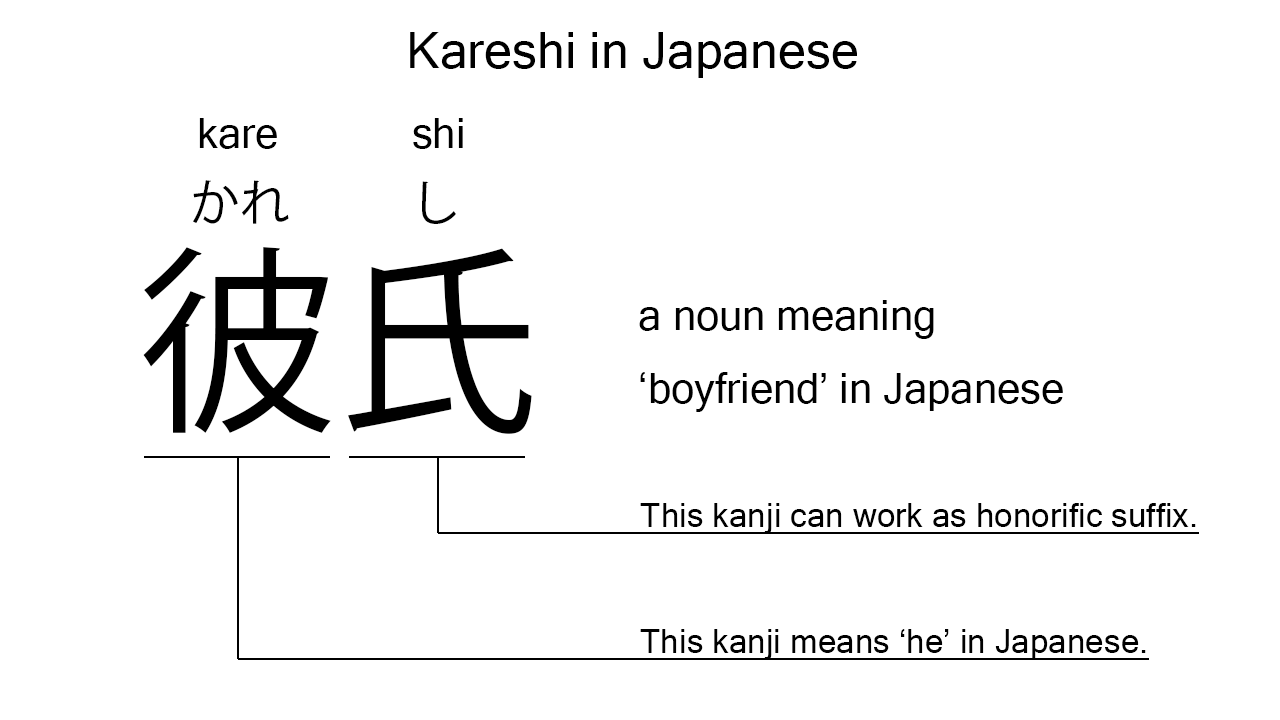What does “kareshi” mean in Japanese?
Native speakers say “kareshi” to mean ‘boyfriend’ in Japanese. Perhaps, some Japanese learners know this word as it is sometimes used in Japanese movies, songs, novels, manga, anime, and the like. In this blog post, however, I will explain this word in detail based on its kanji expression. And also, I will explain how to use it through example sentences. My explanations would help Japanese learners understand “kareshi” more clearly. Then, let’s get started!
Contents
Definition and meaning of “kareshi”
Let me start with the definition and meaning of “kareshi”.
- kareshi – 彼氏 (かれし) : a noun meaning ‘boyfriend’ in Japanese.
Native speakers use this noun to refer to someone with whom a woman is dating or in an intimate relationship. So, it works in more or less the same way as the English noun, “boyfriend”, does.
The definition and meaning are simple and clear. To understand this noun more clearly, however, let me explain its kanji characters in detail, one by one.
What does “kareshi” literally mean in Japanese?
The kanji expression of “kareshi” consists of the following two kanji characters:
- 彼 : a kanji character widely used as a pronoun meaning ‘he’. This can also be used to refer to something not close to the speaker.
- 氏 : a kanji character used as an honorific suffix normally after a name.
These two kanji characters tell us that “kareshi” is literally the honorific expression for a boy or man. This literal interpretation is not completely in line with the actual meaning, but still understandable, I think. A girl or woman should show her respect to her boyfriend even if they are in a very casual relationship.

When we meet new kanji expressions, we should check their kanji characters in detail to understand their meanings clearly and deeply. In many cases, kanji characters tell us a lot about the meanings of the expressions they form. Actually, here, we could get the better understanding of “kareshi” through the detailed kanji check above.
So far, I’ve explained the definition and meaning of “kareshi” together with its kanji characters. Then, let me explain how to use it through the example sentences below.
Example #1: how to say “boyfriend” in Japanese
watashi no kareshi wa totemo kakkoii – 私の彼氏はとてもかっこいい (わたしのかれしはとてもかっこいい)
My boyfriend is very handsome.
Below are the new words used in the example sentence.
- watashi – 私 (わたし) : a pronoun meaning ‘I’ in Japanese.
- no – の : a case particle used after a noun or pronoun to make its possessive case. In the example, this is used after “watashi” to make its possessive case, “watashi no“, which means ‘my’ in Japanese.
- wa – は : a binding particle working as a case marker or topic marker. In the example, this works after “watashi no kareshi” to make the subject in the sentence.
- totemo – とても : an adverb of degree meaning ‘very’, ‘much’, ‘so’, or such in Japanese. In the example, this works before “kakkoii” to emphasize its meaning.
- kakkoii – かっこいい : an i-adjective meaning ‘handsome’ in Japanese.
This is a typical usage of “kareshi”. In this example, it works as a part of the noun phrase, “watashi no kareshi”, which means ‘my boyfriend’ in Japanese. When we want to say “boyfriend” in Japanese, anyway, this noun is a very good option.
Example #2: another usage of “kareshi”
boku ga kanojo no kareshi desu – 僕が彼女の彼氏です (ぼくがかのじょのかれしです)
I am her boyfriend.
Below are the new words used in the example sentence.
- boku – 僕 (ぼく) : a pronoun meaning ‘I’ in Japanese. This is used mainly by boys and young males.
- ga – が : a case particle used to make the subject word or the object word in a sentence. In the example, this is used after “boku” to make the subject in the sentence.
- kanojo – 彼女 (かのじょ) : a pronoun meaning ‘she’ in Japanese. In the example, this works together with the case particle, “no”, to say “her” in Japanese.
- desu – です : an auxiliary verb used after a noun or adjective to make it polite. Probably, this is well known as a part of Japanese desu form. In the example, this is used after “kanojo no kareshi” to make it sound polite.
This is another typical usage of “kareshi”. In this example, it works as a part of the noun phrase, “kanojo no kareshi”, which means ‘her boyfriend’ in Japanese.
Summary
In this blog post, I’ve explained the definition and meaning of “kareshi” in detail based on its kanji expression. And also, I’ve explained how to use it through the example sentences. Let me summarize them as follows.
- kareshi – 彼氏 (かれし) : a noun meaning ‘boyfriend’ in Japanese. Native speakers use this noun to refer to someone with whom a woman is dating or in an intimate relationship. These two kanji characters are literally the honorific expression for a boy or man. This literal interpretation is not completely in line with the actual meaning, but still understandable, I think. A girl or woman should show her respect to her boyfriend even if they are in a very casual relationship.
Hope my explanations are understandable and helpful for Japanese learners.